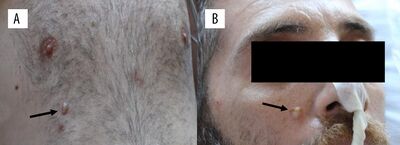Cutaneous amoebiasis
Jump to navigation
Jump to search
| Cutaneous amoebiasis | |
|---|---|
| Other names: Aoebiasis cutis,[1] | |
 | |
| a,b)Cutaneous amebiasis lesions present on chest and face | |
Cutaneous amoebiasis, refers to a form of amoebiasis that presents primarily in the skin. It can be caused by Acanthamoeba[2][3] or Entamoeba histolytica.[4]: 421 [5] When associated with Acanthamoeba, it is also known as "cutaneous acanthamoebiasis".[6] Balamuthia mandrillaris can also cause cutaneous amoebiasis, but can prove fatal if the amoeba enters the bloodstream [7][8]
It is characterized by ulcers. Diagnosis of amebiasis cutis calls for high degree of clinical suspicion. This needs to be backed with demonstration of trophozoites from lesions. Unless an early diagnosis can be made such patients can develop significant morbidity.[9]
See also
References
- ↑ Bumb RA, Mehta RD (2006). "Amoebiasis cutis in HIV positive patient". Indian J Dermatol Venereol Leprol. 72 (3): 224–6. doi:10.4103/0378-6323.25786. PMID 16766840.
- ↑ "EyeRounds.org:Acanthamoeba Keratitis: 39-year-old contact lens wearer with persisting keratitis & pain". Archived from the original on 2008-12-05. Retrieved 2009-01-17.
- ↑ Walia R, Montoya JG, Visvesvera GS, Booton GC, Doyle RL (March 2007). "A case of successful treatment of cutaneous Acanthamoeba infection in a lung transplant recipient". Transpl Infect Dis. 9 (1): 51–4. doi:10.1111/j.1399-3062.2006.00159.x. PMID 17313473. S2CID 36545333.
- ↑ James, William D.; Berger, Timothy G.; et al. (2006). Andrews' Diseases of the Skin: clinical Dermatology. Saunders Elsevier. ISBN 0-7216-2921-0.
- ↑ Kenner BM, Rosen T (2006). "Cutaneous amebiasis in a child and review of the literature". Pediatr Dermatol. 23 (3): 231–4. doi:10.1111/j.1525-1470.2006.00223.x. PMID 16780468. S2CID 43245801.
- ↑ Da Rocha-Azevedo, B.; Tanowitz, H.; Marciano-Cabral, F. (2009). "Diagnosis of infections caused by pathogenic free-living amoebae". Interdisciplinary Perspectives on Infectious Diseases. 2009: 251406. doi:10.1155/2009/251406. PMC 2719787. PMID 19657454.
- ↑ Rocha-Azevedo B, Jamerson M, Cabral GA, Silva-Filho FC, Marciano-Cabral F (January 2007). "The interaction between the amoeba Balamuthia mandrillaris and extracellular matrix glycoproteins in vitro". Parasitology. 134 (Pt 1): 51–8. doi:10.1017/S0031182006001272. PMID 17032481. S2CID 27417759.
- ↑ Pritzker AS, Kim BK, Agrawal D, Southern PM, Pandya AG (February 2004). "Fatal granulomatous amebic encephalitis caused by Balamuthia mandrillaris presenting as a skin lesion". J. Am. Acad. Dermatol. 50 (2 Suppl): S38–41. doi:10.1016/s0190-9622(03)02090-5. PMID 14726864.
- ↑ Verma, Ghanshyam K; Sharma, Nand Lal; Shanker, Vinay; Mahajan, Vikram K; Kaushik, Rajani; Verma, Santwana; Jindal, Nidhi (February 2010). "Amoebiasis cutis: Clinical suspicion is the key to early diagnosis". Australasian Journal of Dermatology. 51 (1): 52–55. doi:10.1111/j.1440-0960.2009.00594.x. PMID 20148845. S2CID 205454111.
External links
| Classification |
|---|